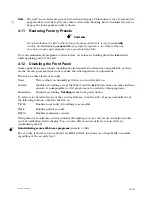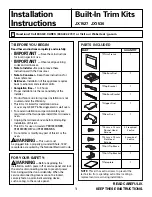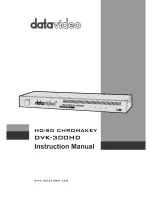
6-2
Rev 2.2, 10/31/94
If you are using the digital inputs, connect them to an appropriate digital source. Set the push-
push switch to correspond to the input that you are using.
If you are using the digital outputs, connect them to an appropriate digital input. Set the push-
push switch to correspond to the output that you are using.
There is no need to observe polarity with regard to either of the AES/EBU I/O connectors. The
digital system is immune to polarity reversals on the signal wiring.
Connect the AC input to an AC power source of the proper voltage and frequency, as marked on
the rear of the unit.
Caution:
Failure to connect the
601
to the proper AC mains
voltage may cause fire and/or internal damage. There are no
user serviceable parts inside the chassis. Refer all service to
qualified service personnel or to the factory.
Warning:
Lethal voltages are present inside the
chassis. There are no user serviceable parts inside the
chassis. Refer all service to qualified service personnel or
to the factory.
6.2 Settings for Analog Sources
For an analog source, Figure 6-2 and Figure 6-3 show the wiring required. Set the controls
and switches on the front panel as follows:
1. After all rear-panel input and output connections have been made, apply power to the
601
and depress the
P
OWER
switch. When the display shows program number 1, proceed to the
next step.
2. Depress
the
G
LOBAL
switch once. The display reads
GAIn
. Rotate the Wheel to set the digital
input gain (this is not the gain applied to AES/EBU or S/PDIF sources) to
0
.
3. Depress
the
G
LOBAL
switch again The display reads
Pd--
. Rotating the Wheel enables or
disables the microphone input
15 dB
pad. Rotate the Wheel to select
Pd--
or
PAd
(pad in).
4. Depress
the
G
LOBAL
switch again. The display reads
InP
. Rotating the Wheel selects the
input source and routing as indicated by the
D
IGITAL
/M
IC
/L
INE
LEDs and the display. The
input possibilities are: digital, mic, mic + line (mic/line mix), line. Rotate the Wheel to select
the mic, line, or mic + line inputs.
5. Depress
the
G
LOBAL
switch again; the display reads
bAr1
.
6. Depress
the
G
LOBAL
switch again. The display reads
CLCI
. Rotating the Wheel selects the
clock source for the digital processors. If set to
CLCI
the clock source is the internal 48 kHz
or 44.1 kHz crystal oscillator. If the display reads
CLCE
the clock source is the rear-panel
digital input. Refer to Chapter 4 for additional information. Select
CLCI
.
7. Depress
the
G
LOBAL
switch again. The display reads n
P--
(not protected) or
Prt
(protected).
Select memory protection as required.
8. Depress
the
G
LOBAL
switch again. The display reads
44.1
or
48.0.
This represents the two
sample rates (only if you haven’t selected CLCE in step 5. Rotate the Wheel to select the
sample rate appropriate to your application.
9. Depress
the
LEVEL
switch. The display reads
L 0.0
. If not, rotate the Wheel until the display
reads
L 0.0
. This sets the output gain to 0 dB.
Содержание 601
Страница 46: ...4 18 Rev 2 2 10 31 94 This page is blank believe it or not ...
Страница 48: ...4 20 Rev 2 2 10 31 94 Notes ...
Страница 50: ...5 2 Rev 2 2 10 31 94 Notes ...
Страница 70: ...7 16 Rev 2 2 10 31 94 Notes ...
Страница 72: ...8 2 Rev 2 2 10 31 94 Notes ...
Страница 74: ...9 2 Rev 2 2 10 31 94 Notes ...
Страница 78: ...11 2 Rev 2 2 10 31 94 Notes ...
Страница 126: ...D 12 Rev 2 2 10 31 94 Notes ...
Страница 138: ...G 8 Rev 2 2 10 31 94 Notes ...
















































